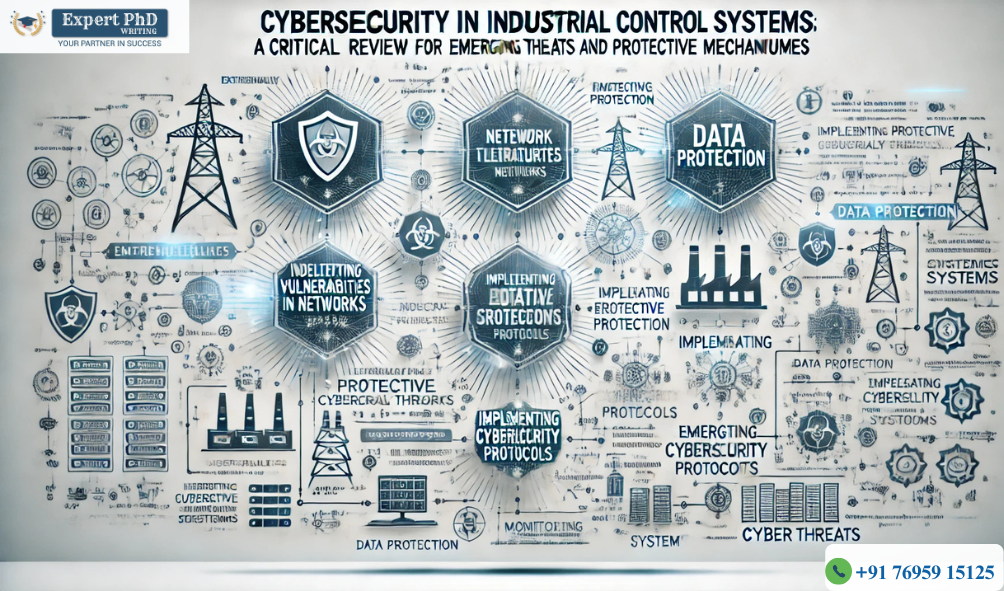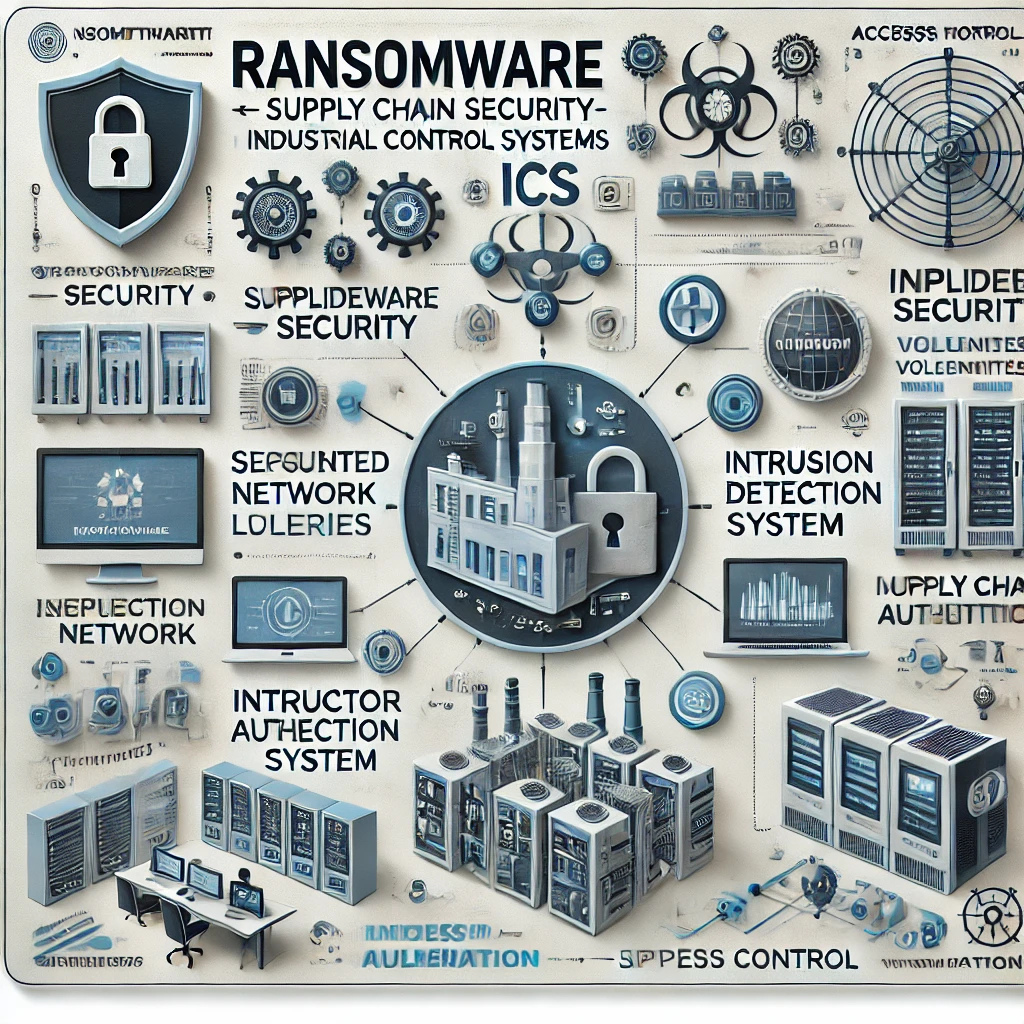
Cybersecurity in Industrial Control Systems: A Critical Review of Emerging Threats and Protective Mechanisms
Introduction
Industrial Control Systems (ICS) are critical components in sectors such as energy, manufacturing, water, and transportation. These systems ensure continuous operation and often interface with operational technology (OT) and information technology (IT). The integration of digital technology into ICS has significantly improved operational efficiency but has also introduced new cybersecurity vulnerabilities. With the convergence of OT and IT, ICS are increasingly exposed to cyber threats, which can disrupt essential services and, in severe cases, lead to economic or environmental disasters. This review critically examines emerging cybersecurity threats to ICS and explores protective mechanisms to mitigate these risks.
Emerging Threats to ICS
Advanced Persistent Threats (APTs)
APTs are sophisticated, long-term attacks where cybercriminals or state-sponsored groups infiltrate systems and gather intelligence over time. These threats are challenging to detect as they are often tailored to specific ICS environments. For example, the Stuxnet worm, designed to damage Iran’s nuclear centrifuges, highlighted how APTs can cause physical harm through cyber means (de Abreu et al., 2020).
Ransomware and Malware Attacks
Ransomware attacks on ICS have become increasingly common, where attackers encrypt system files and demand a ransom for their release. Unlike typical malware, ransomware in ICS can shut down production lines or interrupt service delivery, causing significant financial loss and safety risks. An example is the ransomware attack on Colonial Pipeline in 2021, which disrupted fuel supplies across the Eastern United States (Pitman & Crosier, 2024).

Insider Threats
Insider threats occur when employees, contractors, or other trusted individuals intentionally or unintentionally compromise ICS security. These individuals may misuse access rights or unintentionally introduce vulnerabilities. The risk of insider threats is heightened by the specialized knowledge insiders have about ICS, making it difficult to detect their actions in real-time.
Supply Chain Attacks
As ICS systems depend on a complex network of third-party vendors, supply chain attacks have become a significant risk. In this attack, adversaries compromise a trusted vendor or software provider, thereby gaining access to ICS through legitimate means. The SolarWinds attack is a recent example, where attackers gained access to multiple ICS by compromising a trusted software update, demonstrating how supply chains can be leveraged to bypass traditional defenses (Sobb et al., 2020).
Protective Mechanisms for ICS
Network Segmentation and Isolation
Segmentation involves dividing the ICS network into smaller, isolated segments. This approach limits the spread of malware or unauthorized access from one segment to another. Isolation of critical ICS networks from external networks minimizes exposure to potential attackers. Employing a “defense-in-depth” approach, where multiple layers of security are in place, can further reinforce network segmentation.
Intrusion Detection and Prevention Systems (IDPS)
IDPS are essential tools for monitoring and alerting unusual network activity in real-time. In ICS, where uninterrupted operation is critical, intrusion detection is designed to identify threats with minimal disruption. Modern IDPS systems use machine learning algorithms to detect anomalies, making it easier to identify APTs or zero-day threats that may otherwise go unnoticed (Alshamrani et al., 2019).
Regular Patch Management
Many ICS rely on legacy software, which is often outdated and lacks proper security features. Regular software patching helps close security vulnerabilities. However, due to the operational demands of ICS, patching schedules must be planned meticulously to avoid downtime. Automated patch management systems, which are becoming more prevalent, can help maintain system security with minimal manual intervention.
Access Control and User Authentication
Effective access control restricts unauthorized access to sensitive ICS areas. Role-based access control (RBAC) allows permissions based on users’ roles within the organization, limiting access to critical functions. Multi-factor authentication (MFA) can add an additional layer of security, ensuring that only authorized personnel can access critical systems.

Supply Chain Risk Management
To mitigate supply chain risks, organizations can perform thorough assessments of vendors and require compliance with cybersecurity standards. Supply chain risk management frameworks can help organizations to identify, assess, and respond to vulnerabilities introduced through third-party suppliers. Developing partnerships and sharing threat intelligence with suppliers further enhances resilience against supply chain attacks (Colicchia et al., 2019).
Conclusion
The cybersecurity landscape for Industrial Control Systems is rapidly evolving, with emerging threats such as APTs, ransomware, insider threats, and supply chain vulnerabilities posing serious risks. Effective cybersecurity for ICS requires a multifaceted approach, including network segmentation, robust intrusion detection systems, timely patching, access controls, and proactive supply chain management.
References
- Alshamrani, A., Myneni, S., Chowdhary, A., & Huang, D. (2019). A survey on advanced persistent threats: Techniques, solutions, challenges, and research opportunities. IEEE Communications Surveys & Tutorials, 21(2), 1851-1877. 10.1109/COMST.2019.2891891 [IDPS]
- Colicchia, C., Creazza, A., & Menachof, D. A. (2019). Managing cyber and information risks in supply chains: insights from an exploratory analysis. Supply Chain Management: An International Journal, 24(2), 215-240. https://doi.org/10.1108/SCM-09-2017-0289 [Supply Chain Risk Management]
- de Abreu, S. F., Kendzierskyj, S., & Jahankhani, H. (2020). Attack Vectors and Advanced Persistent Threats. Cyber Defence in the Age of AI, Smart Societies and Augmented Humanity, 267-288. https://doi.org/10.1007/978-3-030-35746-7_13 [APTs]
- Pitman, L., & Crosier, W. (2024). On the scale from ransomware to cyberterrorism: the cases of JBS USA, colonial pipeline and the wiperware attacks against Ukraine. Journal of Cyber Policy, 1-21. https://doi.org/10.1080/23738871.2024.2377670 [Ransomware Attack]
- Sobb, T., Turnbull, B., & Moustafa, N. (2020). Supply chain 4.0: A survey of cyber security challenges, solutions and future directions. Electronics, 9(11), 1864. https://doi.org/10.3390/electronics9111864 [Supply Chain]